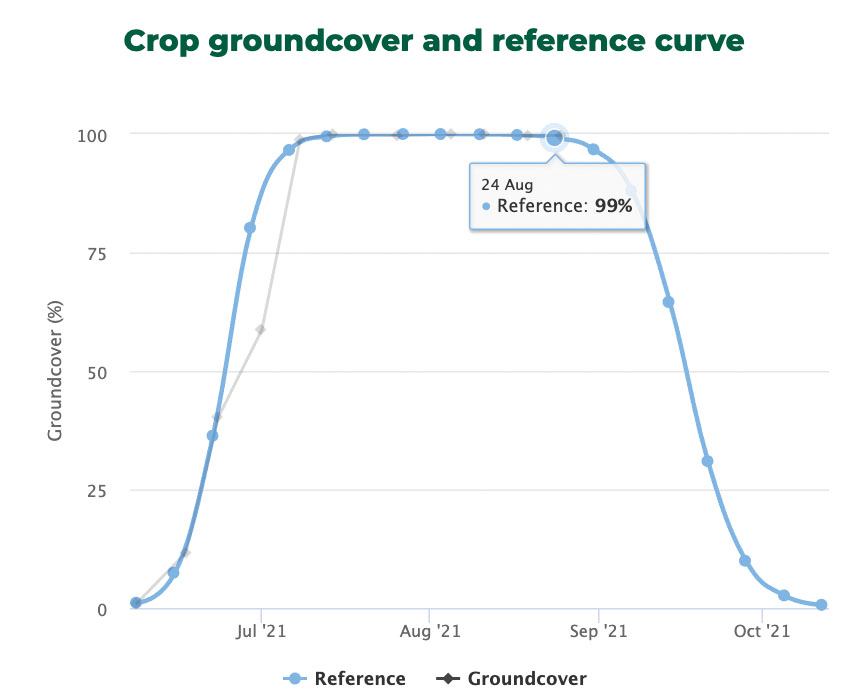How a digital tool can help get MH spray timing spot on
11th July 2022
As the starting point of potato sprout suppression programmes, getting the most out of maleic hydrazide (MH) is paramount for successful, cost-effective storage. Farmers Guide finds out how crop modelling platform Crop4Sight can help.
Correct application timing is essential in maximising efficacy of maleic hydrazide in potatoes and digital tool Crop4Sight can help growers pinpoint the optimum spray window.
Maleic hydrazide, in products like Crown MH, has had a role in potato crops for many years, with the historic key driver control of volunteers that can harbour pests and diseases throughout the rotation.
More recently, it has become the foundation of sprout control for crops destined for store, where it can reduce or eliminate need for further, more treatments.
Uptake into tubers has the greatest influence on efficacy and maximising uptake relies on applying when the crop is actively growing, and environmental conditions are optimum.
Limited leg work
In the past, the process of getting timing right has rested on time-consuming field inspections and keeping a keen eye on weather forecasts.
However, growers now have access to data-driven tools like Crop4Sight to eliminate some of this leg work.
Crop4Sight managing director Paul Coleman says that the precision crop management tool has several functions for potato growers, including a seed module for bespoke seed rate planning.
Its output is based on a seed lot’s chronological condition, contract and marketable yield requirements and harvest dates, rather than a standard recommendation from the seed house.
With the input of information like variety, planting date and first emergence date, it can also provide forecasts for stages of crop emergence, tuber initiation, canopy development, total and marketable yield, and tuber numbers.
Some of these features require further data input from the grower or agronomist, such as an early stem count, which feeds into tuber number forecast, and size and weight graded yield digs, which ground truths yield forecasts and flags any problems within each crop.
Canopy development
Paul says there are two aspects of Crop4Sight which are key when planning its use – canopy development and marketable yield forecasts.
For canopy development, as soon as the system knows the crop emergence date, it will produce a groundcover curve, like the one below for a crop of Maris Piper grown in 2021.
The blue line is the model’s prediction, and it shows when the canopy should be healthy and with a high degree of accuracy when the crop will start to senesce, which is around 24th August.
The grey line shows actual groundcover from visual analysis, either from uploaded mobile phone images or new for 2022, satellite imagery analysed by an algorithm developed in conjunction with remote sensing specialist Assimila.
“We know that having a healthy canopy is important for maximum uptake of the product, and this tells me I need to get the MH by 20th–22nd August at the latest to be confident of a good result,” explains Paul.
Marketable yield
The next reference point is marketable yield. Growers will have to conduct an early yield dig in the crop, measuring tuber numbers, size, and weight, then enter the information into the Crop4Sight dashboard.
The model then predicts when marketable yield will stop increasing to provide an optimum desiccation date.
It is then possible to count back five weeks from that point to give you an earliest application date for MH.
This, aligned with the groundcover forecast and making sure 80% of tubers are above 25mm diameter, gives you the optimum window of 3–5 weeks desiccation which manufacturers recommend.
This allows sprayer operators some breathing space to wait for the right environmental conditions without applying too early, which can have a negative effect on crop yield.
“We’ve found Crop4Sight a really useful tool for forecasting canopy duration and forecasting yield, giving you the best application window for MH uptake without compromising yield,” Paul explains.
Slow drying
Certis Belchim’s technical specialist Henry Welham (left) says extending drying time on the leaf is the primary aim when using Crown MH, the firm’s non-foaming liquid formulation of maleic hydrazide.
This means that high water rates should be used – at or above 400-litre/ha is best – and spraying in hot and dry conditions avoided. Many operators are now favouring its use in the evening when temperatures are falling.
Relative humidity is also important, and this should be above 75% and unlikely to fall for a few hours after spraying. No rain should be forecast, or irrigation scheduled, for at least 24 hours post application (ideally 48 hours).
“Depending on the season, the optimum spray window can be very tight, so maximising efficiency during the spraying operation is a big help, particularly if you have a large area of potatoes to cover,” explains Henry.
Crown MH comes in standard 20-litre containers, but also 600-litre intermediate bulk containers (IBCs).
The IBC system requires a Fastran 850 closed transfer unit from Wisdom Systems to load chemical into the sprayer at a rate of 25-litres/min with very low operator exposure and once empty, returned for recycling free of charge.
“It’s much faster and safer than lifting, ripping and emptying bags into the induction bowl.
“Operators that have used the IBCs have reported enough saved time to get an extra load or two in over the course of a working day when conditions are right, increasing the chances of a favourable result,” says Henry.
MH application checklist
- Treat healthy and actively growing crops
- Apply 3–5 weeks before haulm destruction when 80% of tubers are >25mm
- Spray on a cool day (<25ºC) when RH is >75% and no rain forecast, or irrigation scheduled for at least 24 hours (ideally 48 hours)
- Avoid using mixing partners – only Ranman Top (cyazofamid) is recommended
- Use high water volume – minimum of 400-litres/ha recommended
- Reduce forward speed of sprayer to 8–12kph.

